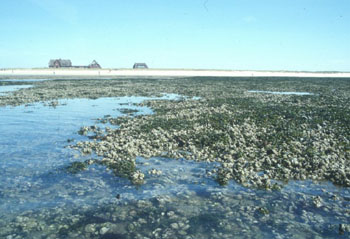
A bed of common mussels in the Wadden Sea near Sylt.
Photo: C. Buschbaum: Tiere und Pflanzen im Watt: "Miesmuschel".
 A bed of common mussels in the Wadden Sea near Sylt. Photo: C. Buschbaum: Tiere und Pflanzen im Watt: "Miesmuschel". |
Systematics:
Mollusca (Molluscs)
![]() Bivalvia
(Mussels and clams)
Bivalvia
(Mussels and clams)
![]() Pteromorphia
Pteromorphia
![]() Mytiloida
(Mussel relatives)
Mytiloida
(Mussel relatives)
![]() Mytilidae
(Blue mussels)
Mytilidae
(Blue mussels)
![]() Mytilus edulis
Mytilus edulis
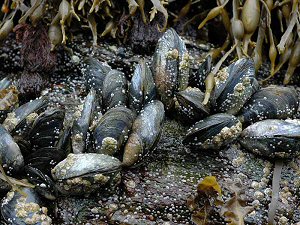 Blue mussels with barnacles. Picture: Keith Hiscock, Marine Life Network. |
The common mussel is a most astounding form of life: In the Wadden Sea common or blue mussels may assemble to form colonies or mussel beds kilometres in size, millions of individual beings covering the sea floor. The common or black mussel can be found in several species on all coasts, provided a suitable underground is present: Mussels may even overgrow artificial structures, such as poles and harbour walls, even chains hanging in the water.
A mussel is a blue-black coloured bivalve with a shell about 10 cm (4 in.) in length, divided into two almost equal halves, making it hard to tell both sides apart. A mussel's shell is often itself overgrown by other sea-living creatures, such as the always present barnacles (Balanus), algae of different kinds and seaweed. As a matter of fact, the mussel beds make a most important part of the ecosystem in the Wadden Sea: They provide living space to over a hundred species of creatures, living on or between them.
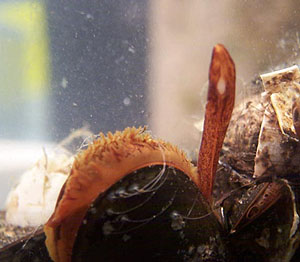 Inhalant (left) and exhalant (centre) siphons of a living mussel In the right of the picture the mussel's foot can be seen. Source: Tiere der Ostsee: Die Miesmuschel. |
Only a small part of a mussel's soft body is usually visible outside of its shell: The strong foot, at the end of which there is a byssus gland. This gland produces a resistant thread made from proteins. This thread is part of the mussels' story of success:
The byssus thread is used by the mussel to steady itself on the ground, as well as on other mussels. On this basis mussel beds come into existence, when millions of mussels cling together with their byssus threads. But there is much more to this unique thread: Using it, mussels also are able to move over the ocean floor, throwing out the byssus like an anchor line and then gradually shortening it.
An Experiment with Mussels:
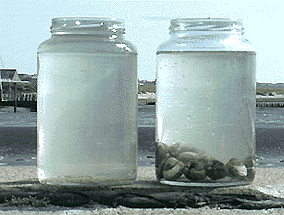 Harbour water from Juist is filled in two glasses. In the right one, a handful of mussels are placed. The left glass is used as comparison. |
|
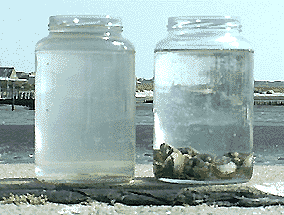 After an hour, the mussels have filtered the water so that it becomes transparent. Source: Aldebaran (1997). |
![]() "Natural
adhesive systems of marine mussels, Mytilus edulis" (INL
research and development). (PDF, 176 KB), on the blue mussel byssus thread.
"Natural
adhesive systems of marine mussels, Mytilus edulis" (INL
research and development). (PDF, 176 KB), on the blue mussel byssus thread.
Apart from the foot, two siphons can be seen, as soon as the mussel opens its shell halves wide enough. A mussel will do so only under water, to breathe and to feed. Like other bivalves, mussels also are filtrators that take oxygen from the surrounding sea water to breathe as well as food particles. In doing so, mussels make a very important part in preserving the ecosystem of the Wadden Sea:
Each individual mussel filters about 2 to 3 litres of sea water per hour. Taking
into account the falling dry of mussels during low tide, that makes about 10 to
20 litres of sea water per day and mussel. Altogether it may be assumed that all
mussels inhabiting it completely filter the Wadden Sea's water during around a
few days. So with some right mussels have been called the sewage water plants of
the Wadden Sea.
But what happens to the suspended particles filtered out of the sea water by a
mussel? From its breathing water, the mussel filters edible particles and
transports them into the digestive tract. Indigestive particles are egested over
the exhalant siphon. So around itself, the mussel accumulates a lot of silt, made of
particles formerly afloat in the sea water.
This is the reason, why the common mussel, like many other bivalve species, is
strongly afflicted by sea water pollution. As they feed by filtration,
mussels especially tend to accumulate harmful substances out of the surrounding
sea. Especially near the estuaries of strongly polluted rivers, such as the
Elbe, the contamination by heavy metals may tenfold surmount the normal.
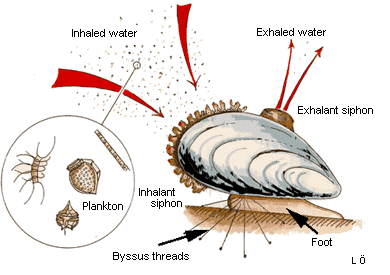 Respiration and nutrition of a common mussel (Mytilus edulis). Source: Aquascope. |
Mussels reproduce like they feed, using the surrounding water. Mussels have separate sexes – there are males and females.
In spring, each mussel female ejects about 5 to 12 millions of eggs into the water, where fertilisation by males of the environment will take place. In ideal cases this will result in a rate of one mussel larva per millilitre sea water!
From a fertilised egg cell the trochophora larva will develop, by a metamorphosis changing into a veliger larva. Those planktontic larval stages may be transported several hundred kilometres by sea currents.
On the other hand, about 99.9% of the planktontic mussel larvae will serve as food to the many plankton feeding sea creatures. Even after this "murderous" selection there are still 10,000 larvae left to develop to juvenile mussels about 3 mm in size, which will attach themselves to algae threads and polyps.
Until they have reached the size of 5 cm, those juvenile mussels may change their place several times, until they finally settle to a suitable piece of ground, preferably near other mussels. Millions of mussels hanging together with their byssus threads mark the development of a mussel bed.
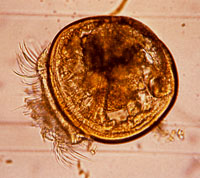 Veliger larva of Mytilus galloprovincialis. Source: Ferrara university. |
The advantage for mussels in a mussel bed is obvious: The chance of sperm cells meeting another mussel's egg cells is much higher that way and so is the chance of fertilisation.
Even after successfully finding a place to attach, mussels are still prey to many enemies in and out of the water. From above the water, gulls and oystercatchers, from under the water eider ducks, sea stars and crabs are a mussel's enemies.
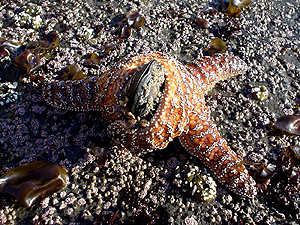 A sea star trying to open a mussel. Picture: Mila Zinkova. |
|
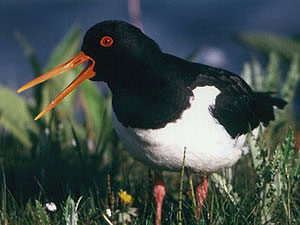 Oystercatchers not only catch oysters. Picture: Eric Poppel |
A proficient mussel raider also is another mollusc: The common whelk (Buccinum undatum). This largest predator snail of the Northern Sea lurks in front of a mussel shell and waits until the mussel is compelled to open up to breathe and feed. Then the gastropod drives its siphon and snout between the mussel's shell halves and feeds on it.
Against smaller predator snails, such as the Northern purple shell, Nucella lapillus, or the netted dog whelk, Hinia reticulata, blue mussels are quite able to defend themselves: They tie down the attacker with byssus threads, so the snail is forced to starve unless it is able to free itself. About 30% of purple snails present in mussel beds get caught that way. Nucella lapillus try to avoid mussel beds, as possible, and are noticeably more frequent outside of them (by a factor of 20).
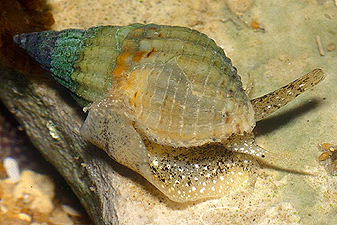 Netted dog whelk (Hinia reticulata). Picture: Eric Walravens. |
Apart from biotic factors there are also certain abiotic factors important to
mussels' life and survival. Mussel beds fallen dry may be destroyed by ice
plates during winter. On the other hands mussel beds fallen dry (also because of
the accumulation of silt due to the mussels' egestion of indigestive particles)
are safe from crabs, whelks and sea stars. A position very little above sea
level has proven favourable for mussel survival. During low tide those mussel
beds lay dry for about four hours, enough to force sea stars and snails to
retreat.
The scientific name Mytilus goes back to Aristotle (384 - 322 BC) in ancient Greece. In his
time, "mutilos" (mytilos) described an edible bivalve. The Latin species name edulis
confirms the fact that common mussels are edible and, apart from that, very tasty. Mussel
fishery has taken place on the German coast of Lower Saxony and
Schleswig-Holstein since more than a hundred years.
Apart from the usual fishing of wild mussels (which for obvious reasons have become quite rare today), from the 1930s on, aquacultures of artificial mussel beds have been built using wild mussels. Those mussel beds are less afflicted by predators and so produce larger mussels ready for harvesting and sale as soon as after one year.
Leading the market in mytiliculture are the Netherlands and Denmark with about
100,000 tons a year, compared to Schleswig-Holstein with 20,000 tons and Lower
Saxony with 8,000 tons.
Sources and further information: